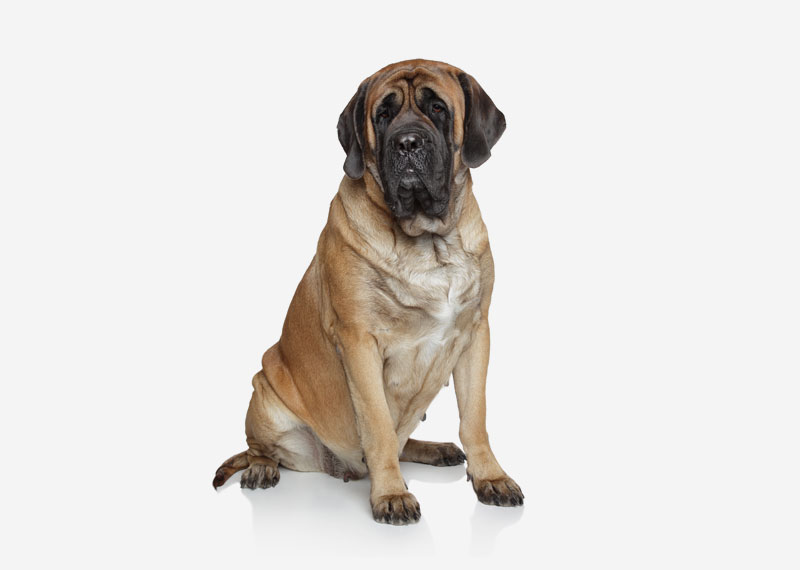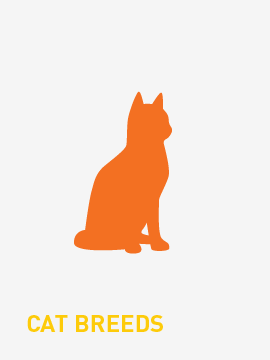The English Mastiff, referred to by most Kennel Clubs simply as the Mastiff, is a breed of large dog perhaps descended from the ancient Alaunt and Pugnaces Britanniae, with a significant input from the Alpine Mastiff in the 19th century. Distinguishable by enormous size, massive head, and a limited range of colours, but always displaying a black mask, the Mastiff is noted for its gentle temperament. The lineage of modern dogs can be traced back to the early 19th century, the modern type was stabilised in the 1880 and refined since. Following a period of sharp decline, the Mastiff has increased its worldwide popularity. Throughout its history, the Mastiff has contributed to the development of a number of dog breeds, some generally known as Mastiff-type dogs or, confusingly, just as "Mastiffs" .
Health
The Mastiff should at all stages of development show the breed characteristics of massiveness and sound, if cumbersome, movement.
The Mastiff is a particularly large dog demanding correct diet and exercise. Excessive running is not recommended for the first two years of the dog's life, in order not to damage the growth plates in the joints of this heavy and fast-growing dog, which in some weeks may gain over 5 lb. However, regular exercise must be maintained throughout the dog's life in order to discourage slothful behaviour and to prevent a number of health problems. A soft surface is recommended for the dog to sleep on in order to prevent the development of calluses, arthritis, and hygroma (an acute inflammatory swelling). Due to the breed's large size, puppies may potentially be smothered or crushed by the mother during nursing. A whelping box, along with careful monitoring can prevent such accidents. The average lifespan of the Mastiff is about 7 years although it's not uncommon for some to live to 10–11 years.Major problems can include Hip dysplasia (canine) and gastric torsion. Minor problems include obesity, osteosarcoma, and cystinuria. Problems only occasionally found include cardiomyopathy, allergies, vaginal hyperplasia, cruciate ligament rupture, hypothyroidism, Osteochondritis dissecans, entropion, progressive retinal atrophy (PRA), and persistent pupillary membranes (PPM).When purchasing a purebred Mastiff, experts often suggest that the dog undergo tests for Hip dysplasia (canine), elbow dysplasia, thyroid, and DNA for PRA.When living in an apartment, it is okay to own a Mastiff, but make sure it will get exercise. These dogs may be related to the dogs that fought lions, tigers, bears, and gladiators in Roman arenas.It is less contentious that the Alaunt is likely a genetic predecessor to the English Mastiff Introduced by the Normans. These dogs were developed by the Alans, who had migrated into France (then known as Gaul) due to pressure by the Huns at the start of the fifth century. Intriguingly they were known from the Romans to live in a region (the Pontic-Caspian Steppe) about 700 km to the north of the region where the Assyrians once lived. Again, any canine connections are speculative.Likely a main progenitor of the Mastiff were the Canes Pugnaces Britanniae or Pugnaces Britanniae for short (Latin meaning "combative (one) of Britannia"), which was the name given by the Roman Britain to the original war-dog of the Britons (Celtic people). (However, the often repeated claim that there was a Roman official, Procurator Gynaecii#The supposed procurator cynegii, especially responsible for purchasing dogs in Britain, is due to a misinterpretation).The origin of the term "Mastiff" is unclear. Many claim that it evolved from the Old English language word "masty", meaning "powerful". Other sources, such as the Oxford English Dictionary, say the word originated from the Old French word mastin (Modern French mâtin), the word being itself derived from Vulgar Latin *ma(n)suetinus "tame", see Classical Latin mansuetus with same meaning.The first list of Dog type#Dog type names in English in the English language, contained within The Book of Saint Albans, published in 1465, includes "Mastiff ". This work is attributed to Prioress Juliana Berners, but in part may be translated from the early 14th century Norman-French work Le Art de Venerie, by Edward II's Huntmaster Guillaume Twici.In 1570, Conrad Heresbach, in Rei Rusticae Libri Quatuor, referred to "the Mastie that keepeth the house". Heresbach was writing in Latin; his work was translated a few years later into English by Barnabe Googe as Foure Bookes of Husbandrie. This work is adapted from Columella#De Re Rustica by 1st century Roman writer Columella, which highlights the Roman connection, but it has been speculated the Mastiff is descended from dogs brought to Britain by the Phoenicians in the 6th century BC. From Roman Empire to Medieval times, these dogs were used in the blood sports of bear-baiting, bull-baiting, dog fighting, and lion-baiting. Dogs known as Bandogs, who were tied (bound) close to houses, were of Mastiff type.They were described by John Caius in 1570 as vast, huge, stubborn, ugly, and eager, of a heavy and burdensome body.When in 1415 Sir Peers Legh was wounded in the Battle of Agincourt, his Mastiff stood over and protected him for many hours through the battle. The Mastiff was later returned to Legh's home and was the foundation of the Lyme Hall. Five centuries later this pedigree figured prominently in founding the modern breed. Other aristocratic seats where Mastiffs are known to have been kept are Elvaston Castle (Charles Stanhope, 4th Earl of Harrington and his ancestors) and Chatsworth House. The owner of the Chatsworth Mastiffs (which were said to be of Alpine Mastiff stock) was William Cavendish, 5th Duke of Devonshire, known to his family as Canis. Mastiffs were also kept at Hadzor, owned by members of the Galton (disambiguation), famous for industrialists and scientists, including Charles Darwin.Some evidence exists that the Mastiff first came to Americas on the Mayflower, but the breed's documented entry to America did not occur until the late 19th century.In 1835, the Parliament of the United Kingdom implemented an Act of Parliament called the Cruelty to Animals Act 1835, which prohibited the bait (dogs) of animals. This may have led to decline in Mastiffs used for this purpose, but Mastiffs continued to be used as guards for country estates and town businesses. Organised breeding began in the 19th century, when J.W. (John Wigglesworth) Thompson sought out a bitch, Dorah, from John Crabtree, the head gamekeeper of Kirklees Hall, whose dogs were often held in the name of his employer, Sir George Armitage. Dorah was descended in part from animals owned by Thompson's grandfather, Commissioner Thompson, at the beginning of the century, as well as a Mastiff of the Bold Hall line, recorded from 1705, a bitch purchased from narrowboat men, another caught by Crabtree in a Red Fox Animal trapping, a dog from Nostal priory and another dog from Walton Hall, West Yorkshire, owned by Charles Waterton, the naturalist. J. W. Thompson's first stud dog Hector came from crossing a bitch, Juno, bought from animal dealer Bill George (dog dealer), to a dog, Tiger, owned by a Captain Fenton. Neither of these had any pedigree, as was normal for the period. Between 1830 and 1850 he bred the descendants of these dogs and some others to produce a line with the short, broad head and massive build he favoured. In 1835, T.V.H. Lukey started his operations by breeding an Alpine Mastiff bitch of the Chatsworth line, Old Bob-Tailed Countess (bought from dog dealer Bill White), to Pluto, a large black Mastiff of unknown origin belonging to the Richard Seymour-Conway, 4th Marquess of Hertford. The result was a bitch called Yarrow, who was mated to Couchez, another Alpine Mastiff belonging (at the time) to White and later mated to a brindle dog also in White's possession. Lukey produced animals that were taller but less massive than Thompson's. After 1850, Thompson and Lukey collaborated, and the modern Mastiff was created, though animals without pedigree or of dubious pedigree continued to be bred from into the 20th century.
Another important contribution to the breed was made by a dog called Lion, owned by Captain (later Colonel) John Garnier of The Royal Engineers. He bought two Mastiffs from the previously mentioned dealer Bill George. The bitch, Eve, bought by George at Leadenhall Market, was old enough to be gray-muzzled, but of good type; the dog, Adam, was of reputed Lyme Hall origin, but bought at Tattersalls and suspected by Garnier of containing a "dash of Boarhound", an ancestral form of Great Dane. Garnier took them with him when he was assigned to Canada and brought back their puppy, Lion. He was bred to Lukey's Countess to produce Governor, the source of all existing Mastiff lines. (Lion was also mated to Lufra, a Scottish Deerhound, and their puppy Marquis appears in the pedigrees of both Deerhounds and Irish Wolfhounds.) In the 1880s soundness was sacrificed for type (widely attributed to the short-headed, massive, but stifle joint and chocolate-masked Ch. Crown Prince). This dog numerically dominated all of his contemporaries in terms of offspring. Subsequently, the Mastiff lost popularity but gained a consistency of type, with leaner, longer-headed specimens becoming relatively less common. Prominent among the breeders of this era were Edgar Hanbury and his relation, the politician and philanthropist Mark Hanbury Beaufoy, later Chairmen of The Kennel Club, who reaching his peak as a breeder with the Crown Prince grandson, Ch. Beaufort, eventually exported to America. Despite such imports, Mastiff numbers in the USA declined steadily through the 1890s and the early 20th century. From 1906 to 1918, only 24 Mastiffs were registered in the United States. After 1910, none of these were bred in America. By the time the First World War ended, other than for a few imports, the breed was extinct outside of Great Britain.
After the First World War
In 1918, a dog called Beowulf, bred in Canada from British imports Priam of Wingfied and Parkgate Duchess, was registered by the American Kennel Club, starting a slow re-establishment of the breed in North America. Priam and Duchess, along with fellow imports Ch Weland, Thor of the Isles, Caractacus of Hellingly and Brutus of Saxondale, ultimately contributed a total of only two descendants who would produce further offspring: Buster of Saxondale and Buddy. There were, however, a number of other imports in the period between the wars and in the early days of the Second World War Those whose descendants still survive were 12 in number, meaning the North American contribution to the gene pool after 1945 consisted of 14 Mastiffs. In the British Isles, virtually all breeding stopped due to the Rationing in the United Kingdom of meat. After the war, such puppies as were produced mostly succumbed to canine distemper, for which no vaccine was developed until 1950. Only a single bitch puppy produced by the elderly stock that survived the war reached maturity, Nydia of Frithend, and her sire had to be declared a Mastiff by the Kennel Club, as his parentage was unknown, and he was thought by some to be a Bullmastiff. After the war, animals from North America (prominently from Canada) were imported. Therefore all Mastiffs in the late 1950s were descended from Nydia and the 14 Mastiffs previously mentioned. It has been alleged that the Mastiff was bred with other more numerous giant dog breed such as Bullmastiffs and St. Bernard dog, as these were considered close relatives to the Mastiff. In 1959, a Dogue de Bordeaux, Fidelle de Fenelon, was imported from France to the USA, registered as a Mastiff, and entered the gene pool. Since that time, the breed has gradually been restored in Britain, has reached 28th most popular breed in the USA, and is now found worldwide.






